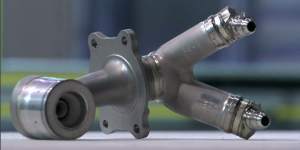It was revealed today that the first engine to feature 3D printed components will also be repairable using tools that are 3D printed. The news comes from a company familiar with the project. The LEAP engine series is manufactured by CFM International, a joint venture of GE Aviation and Snecma. Orders for the engine are in excess of 10,000, generating revenue of over $140 billion. Manufacturers such as Airbus and Boeing are currently testing the engine with their next generation commercial aircraft.
The LEAP engines’ innovative features, such as 3D carbon-fiber matrix material fan blades and most famous 3D printed fuel nozzle of all time, have generated enough text to span many of the routes the engine will eventually fly when it enters service. The engine is the first to contain 3D printed components and also the first to receive simultaneous type certification by the FAA and its European counterpart, EASA. Type certificates are issued by regulators and confirm the airworthiness of a specific design,

Patents filed by GE Aviation illustrate how useful additive manufacturing is for production. One patent describes how, “Traditional methods for making metal leading edge protective strips typically involve multiple steps with intermediate chemical milling or machining.“ This process, “can lead to high tooling costs, high yield losses, and environmentally unfriendly processing.” The filing goes on to describe the advantages that additive manufacturing of these parts brings. Now it seems the same logic will also be applied to servicing and repair of the LEAP engine according to information provided to Aviation Week by a company carrying out the work.
Made by 3D Printing, Repaired by 3D Printing
New information from tool manufacturer Rhinestahl states that the innovative engine will be serviceable using 3D printed tools. The company is a maintenance, repair and overhaul (MRO) specialist and has signed several contracts with LEAP engine owners to perform such work. MRO is an industry valued at $50 billion according to management consultants Oliver Wyman.
Together with Dedienne and AGSE, Rhinestahl were selected by CFM International as authorized tool providers. The unofficial motto of the company is, “the right tools at the right time.”

Dan Hudepohl, LEAP technical program manager at Rhinestahl said, “There are some tools where 3D printing is an optional method for manufacturing” during an interview with Aviation Week. The option to use 3D printed tools may prove very useful in particular situations. As technical manager Zach Buchert notes in the interview, “Different airlines have different workscopes. Some want to be able to do everything, some want to do specific tasks, so a lot of times they do not know what tooling they need.”
Blake Greir is the tooling project leader and confirmed, “there have been a handful of tools that have components that have a 3D printing option.” He went on to add that while the tool set required to perform MRO on the LEAP is not radically different from previous engines, GE have made use of a different palette of materials. In particular aluminum and certain plastics are more common. Greir believes this is due to the lightweight properties these material confer. This indicates that GE are keen to ensure that ergonomic considerations are taken into account. But this is not a major departure from previous practices and Greir notes, “we’re just seeing more of one type of material than we used to see in the past.”
New technology needs a new thought process
As we reported recently, 3D printing is already in use on factory and assembly line floors across the globe for the very purpose of improving worker performance and comfort by considering ergonomic design. An example is BMW’s thumb tool that uses 3D printing to fabricate a device to protect workers from repetitive strain injury specific to a particular task. In this case the task of manually adding rubber buttons to vehicles.

Hudepohl says that 3D printing will not be the only technique used to fabricate any specialist tools that are required. During the interview he said engineers, “can also manufacture them with molds or however it calls out. They’re starting to incorporate different manufacturing capabilities as things evolve.” Mold making using 3D printing is also an area where a number of interesting developments have taken place. For example Voxeljet’s use of the Phenolic-Direct Binding method to create complex molds with impressive levels of detail and strength using silica sand.
Buchert also pointed out that, “the engine technology is so new and different that it all really requires all-new tooling as well as almost a new thought process.”
The LEAP engine aircraft maintenance manual is scheduled for publication in early July and we’ll be sure to bring you the latest news on how 3D printing is at the core of next generation of engines.
The full interview is available here.


